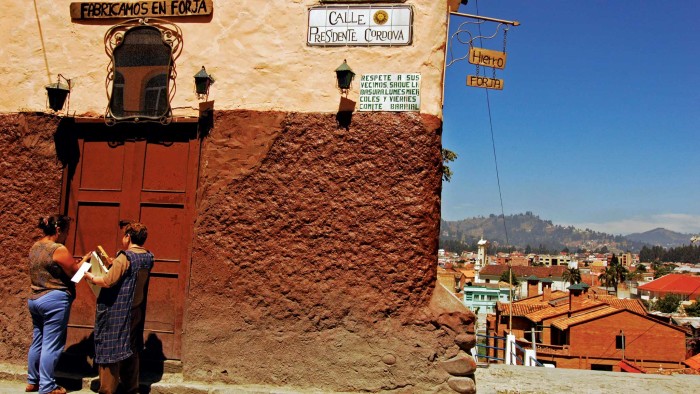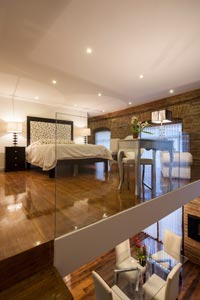Foreign buyers help spark property boom in Ecuador’s Cuenca

Roula Khalaf, Editor of the FT, selects her favourite stories in this weekly newsletter.
In recent years Cuenca, Ecuador’s third-largest city, has quietly emerged as one of the most popular expatriate communities in all of Latin America. Set on the banks of the Tomebamba River in Ecuador’s southern highlands, the city is a 45-minute flight from the capital, Quito. Cuenca’s moderate costs and mild temperatures have made it a magnet for North American retirees. Indeed, upwards of 4,000 foreigners are thought to have settled in Cuenca over the past decade, most over the age of 50, but many far younger with an eye toward entrepreneurship or “telecommuting” with their offices back home.
Cuenca was an Inca stronghold before Spanish conquistadors arrived in the mid-16th century. The Spaniards named it after the home town of Andrés Hurtado de Mendoza, then Viceroy of Peru, and went on to build one of South America’s most beautiful colonial cores. Today this assemblage of churches, plazas, homes and municipal buildings has been declared a Unesco World Heritage Site, an honour that complements the Cuenca region’s robust industrial, manufacturing and agricultural sectors.
A century ago Cuenca became rich from the supply of “Panama” hats, actually made from toquilla palm grown on local farmland. The hat industry still thrives, the tourist trade is lucrative and Cuenca produces much of Ecuador’s ceramics, tyres, furniture and jewellery.
Cuenca has been slowly luring American expats for more than a decade, but that trickle turned into a torrent in 2009 when International Living magazine ranked Ecuador the “world’s best” retirement location, and Cuenca as Ecuador’s top city. Supporting this status is Cuenca’s rich cultural life – from its Spanish-language academies and symphony orchestra to film festivals and an art biennial – along with around 20 medical centres and easy access to Ecuador’s Pacific coast beaches.

Cuenca’s public sector is investing in the city both to attract foreigners and to improve overall quality of life. The local municipality has launched a series of infrastructure upgrades including bike paths, pedestrian walkways, underground parking facilities and a $230m light-rail system predicted to carry 100,000 passengers per day.
“Cuenca offers newcomers a really enviable quality of life,” says Jorge Espinosa, whose tourism firm Luxury Destinations Ecuador has launched a real estate division. “Along with its reasonable size, Cuenca is at a lower altitude than Quito, which means warmer temperatures,” he adds, “while its numerous cultural offerings have helped give the city the title ‘Athens of the Andes’.”
Compared with other Latin American retirement communities such as Panama City or Mexico’s San Miguel de Allende, Cuenca remains relatively affordable. Housing costs, priced in Ecuador’s US dollar currency, are roughly $1,000 per sq metre for a condo and $600-$800 per sq metre for a private house, according to David Morrill, partner at Cuenca Real Estate. Those figures might be between a half and two-thirds of the rates in Panama and San Miguel, but Morrill says Cuenca home prices have risen roughly 10 per cent annually for the past five years.
“Cuenca is catching up after the prolonged recession following Ecuador’s late-1990s economic collapse,” says Morrill, who moved to Cuenca from Florida in 2004. “The market was virtually flat for almost a decade.” Despite its trove of colonial architecture, most foreigners prefer to buy new flats outside of Cuenca’s historic core in the Puertas del Sol neighbourhood, nicknamed “Gringolandia”.

Morrill estimates there are some 30 condominium projects now under construction, most bought off-plan well before completion. “Along with providing America-style comforts, the developments offer safety and security,” says Morrill. “With many foreigners living in Cuenca part-time or travelling extensively through the region, they appreciate the ‘lock-and-leave’ aspect of new construction.”
In Puertas del Sol, Morrill is currently offering a two-bedroom/two-bathroom, 1,100 sq ft home for $125,000, along with a four-bedroom, 3,100 sq ft property for $220,000.
Meanwhile, in the city centre – known as El Centro – preservation-minded local developers are now restoring and converting historic buildings into “turnkey”-styled upmarket apartments. The high-end movement is still in its infancy, slowed by strict landmark laws, complex bureaucracy and a lack of suitable housing stock. But this market, with its 20 per cent premium over new-build condos, is proving lucrative, says Juan Heredia, one of the first developers to enter El Centro.
American Ashley Rogers lives in one of Heredia’s conversions, a 2,000 sq ft loft purchased for $148,000 in 2011 and now worth roughly $275,000. Rogers co-runs Ecuador At Your Service, a concierge agency for foreign visitors or potential expatriates. For Rogers, the “Gringo invasion” has not been large enough to generate real resentment among veteran Cuencanos. In fact, with Ecuador’s economy continuing to expand rapidly, “there is a real sense of optimism here right now”, she says. “It sort of feels like America in the 1950s.”
——————————————-
Buying guide
● Temperatures in Cuenca are roughly the same year-round, generally about 20 degrees, with a rainy winter (January-March) and dry summer (June-September)
● Ecuador grants “real estate visas” to foreigners purchasing homes worth at least $25,000
● “Pensioner visas” are available to foreigners with a retirement income of at least $800 per month
● Ecuador’s generous social services schemes provide low-cost healthcare (roughly $50 a month) for over-65s, including registered foreigners
What you can buy for . . .
$100,000: A two-bedroom condo with 24-hour security
$250,000: A four-bedroom private home about 10 minutes from El Centro
$425,000: A 4,000-plus sq ft, three-storey penthouse in Puertas del Sol
Comments